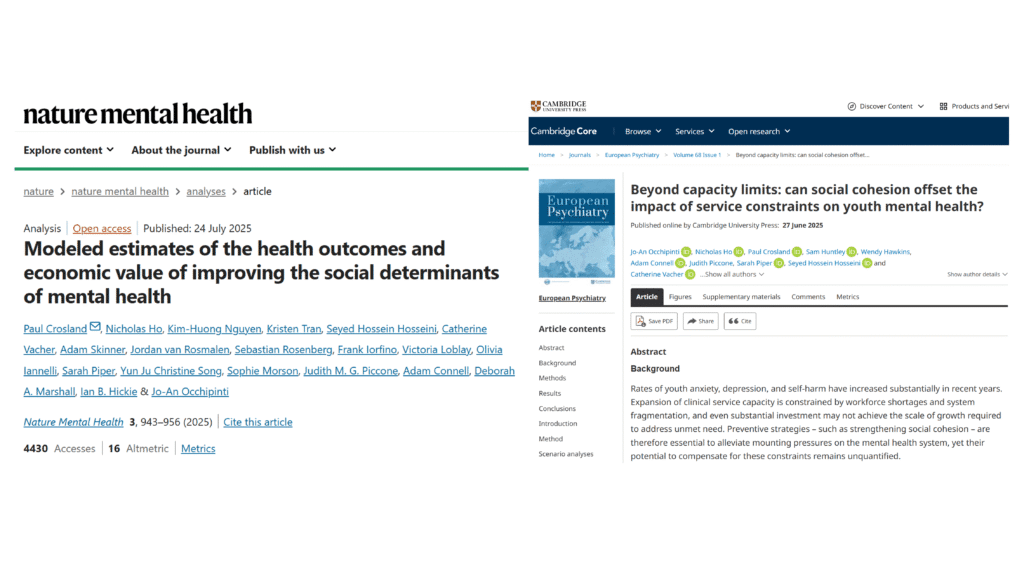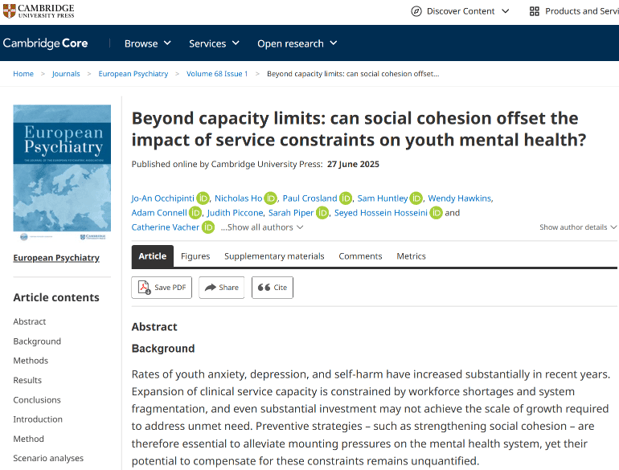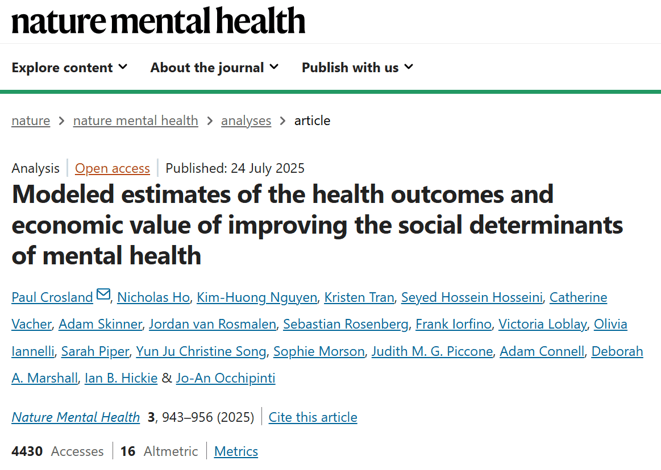
I am delighted to share two new publications that I co-authored, which extend our research at the University of Sydney’s Brain and Mind Centre on the broader social determinants of youth mental health and wellbeing. Both studies highlight how upstream social factors and community dynamics can play a critical role in shaping mental health outcomes—sometimes as much as service expansion itself.
Beyond capacity limits: can social cohesion offset the impact of service constraints on youth mental health?

This work explored whether social cohesion can buffer the impacts of constrained service growth on youth mental health. Our system dynamics model revealed that while expanding specialized services has the strongest direct impact, strengthening social cohesion can meaningfully offset capacity limitations.
For example, with only 80% of baseline service growth, increasing social cohesion still reduced years lived with symptomatic disorder by 6.3%. Combined strategies (service expansion + social cohesion) delivered the greatest improvements.
Improving social cohesion alongside mental health services leads to significantly better outcomes — including fewer ED visits and reduced years lived with mental disorder.
Access the paper
This is published in the European Psychiatry and is accessible HERE.
Full Abstract
Background
Rates of youth anxiety, depression, and self-harm have increased substantially in recent years. Expansion of clinical service capacity is constrained by workforce shortages and system fragmentation, and even substantial investment may not achieve the scale of growth required to address unmet need. Preventive strategies – such as strengthening social cohesion – are therefore essential to alleviate mounting pressures on the mental health system, yet their potential to compensate for these constraints remains unquantified.
Methods
This study employed a system dynamics model to explore the interplay between service capacity and social cohesion on youth mental health outcomes. The model was developed for a population catchment characterized by a mix of urban, suburban, and rural communities. Primary outcomes were prevalence of psychological distress and mental disorders, and incidence of mental health-related emergency department (ED) presentations among young people aged 15–24 years, projected over a 10-year time horizon. Two-way sensitivity analyses of services capacity and social cohesion were conducted.
Results
Changes to specialized mental health services capacity growth had the greatest projected impact on youth mental health outcomes. Heatmaps revealed thresholds where improvements in social cohesion could offset negative impacts of constrained service capacity. For example, if services capacity growth was sustained at only 80% of baseline, improving social cohesion could still reduce years lived with symptomatic disorder by 6.3%. To achieve a similar scale of improvement without improvements in social cohesion, the current growth rate in services capacity would need to be more than double. Combining a doubling of service capacity growth with reversing the decline in social cohesion could reduce ED presentations by 25.6% and years with symptomatic mental disorder by 19.2%. A doubling of specialized, headspace, and GP services capacity growth could prevent 24,060 years lived with symptomatic mental disorder among youth aged 15–24.
Conclusions
This study provides a quantitative framework for understanding how social cohesion improvements can help mitigate workforce constraints in mental health systems, demonstrating the value of integrating service expansion with social cohesion enhancement strategies.
Keywords: health systems, system dynamics, social cohesion, workforce, youth mental health
Modeled estimates of the health outcomes and economic value of improving the social determinants of mental health

This study quantified the health and economic benefits of improving key social determinants—including social cohesion, childhood adversity, substance misuse, and unemployment—in Brisbane South. Using system dynamics modelling, we showed that even modest improvements in these determinants deliver substantial gains in quality of life, reductions in suicide and self-harm, and economic benefits over 11 years.
Access the paper
This is published in the European Psychiatry and is accessible HERE.
Full Abstract
The prevalence and burden of mental disorders have worsened despite increased community awareness. Enhanced access to treatments alone is unlikely to deliver improvements in population mental health, so more attention needs to be paid to social and environmental influences. Here we estimate the health benefits and economic value of improving the social determinants of mental health within Brisbane South, a diverse population of 1.2 million people, in Australia. The incremental net monetary benefit (combining costs and monetized health outcomes) derived from 5% improvements in the average yearly change of social cohesion, childhood difficulties, substance misuse and unemployment over 11 years from 2024 to 2034 was projected to be AUD$146.64 million, AUD$234.50 million, AUD$281.67 million and AUD$100.43 million, respectively. Quality-adjusted life years, suicide deaths, emergency department presentations and self-harm hospitalizations were also improved. This study demonstrates the health and economic value of investing in the social determinants of mental health.
Together, these two publications underscore the importance of looking beyond clinical services to consider social and community-level strategies in building sustainable mental health systems. They demonstrate that policies addressing both capacity and social determinants are essential for long-term population mental health.

Let’s learn Systems Modelling together!
I share useful information about Systems Modelling here weekly.